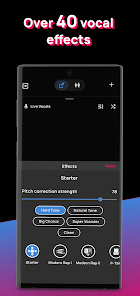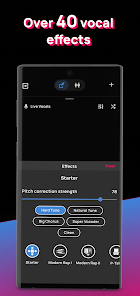How to Record Your Voice Like a Studio If you’re looking to capture your voice like a professional, you’ll need to know how to record your voice like a studio. Recording your voice like a studio means using professional recording equipment and techniques to produce high-quality audio recordings. There are a few things you’ll need to do to get started, and this guide will teach you everything you need to know.

1. How to record your voice like a studio
First, let’s talk about what you need in order to get started. You’ll need a microphone, of course, and a recording interface. The recording interface will connect your microphone to your computer so that you can record your voice.
There are a few different types of microphones that you can use, but for recording your voice, you’ll want to use a condenser microphone. Condenser microphones are more sensitive than other types of microphones, so they’ll pick up your voice more clearly.
When you’re choosing a recording interface, you’ll want to make sure that it has a good preamp. The preamp is what amplifies the signal from your microphone so that it can be recorded. A good preamp will make a big difference in the quality of your recordings, so it’s worth getting a good one.
Now that you have the equipment you need, let’s talk about how to actually record your voice. The first thing you need to do is find a quiet place to record. If you’re recording at home, you might want to consider setting up a makeshift recording studio in a quiet room.
Once you’ve found a quiet place to record, the next step is to set up your microphone. Make sure that the microphone is positioned so that it’s pointing directly at your mouth. You might need to experiment with the positioning a bit to get it just right.
Once your microphone is in position, it’s time to start recording. Before you start recording, though, it’s a good idea to do a test recording to make sure that everything is set up correctly.
To do a test recording, simply hit the record button on your recording interface and start talking. Once you’re done, hit the stop button and listen back to your recording.
If everything sounds good, then you’re ready to start recording for real. If not, make any necessary adjustments and try again.
When you’re ready to start recording, hit the record button and
2. Tips to make your voice sound like a professional
If you are looking to add a professional touch to your recordings, there are a few things you can do to make your voice sound its best. By following these tips, you can make sure that your voice sounds clear, polished, and ready for anything.
1. Use a Pop Filter
A pop filter is a small screen that you place in front of your microphone to catch any unwanted pops or clicks that may occur when you speak. By using a pop filter, you can reduce the amount of background noise in your recording, making your voice sound more clear and professional.
2. Use a Good Microphone
Using a good microphone is essential for getting a clear recording. If you are recording on your computer, make sure to use a USB microphone for the best results. If you are using a mobile device, there are a number of high-quality external microphones that can be used to get a great recording.
By following these tips, you can make sure that your voice recordings sound their best. By using a pop filter and a good microphone, you can reduce background noise and get a clear, professional sounding recording.
3. Steps to take to sound like a studio
Have you ever wondered how the professionals make their recordings sound so clean and polished? Here are three steps you can take to get that studio quality sound for your own recordings.
1. Use a good microphone
This is probably the most important step. A good microphone will capture your voice with all the nuance and detail that you want to convey. It will also help to reduce background noise and other distractions.
2. Use a pop filter
A pop filter is a simple piece of equipment that you can attach to your microphone. It helps to reduce the “popping” sound that can occur when you say certain words. This can make a big difference in the quality of your recording.
3. Use a quiet room
No matter how good your microphone is, it won’t do you any good if your recording environment is full of noise. Try to find a quiet room where you can record without any distractions.
By following these three steps, you can make your recordings sound more like they were done in a professional studio.
4. How to make your voice sound richer
When it comes to recording your voice, there are a few things you can do to make it sound richer. Here are four tips to help you get started:
1. Use a good microphone
This is perhaps the most important tip. If you’re using a cheap or poor-quality microphone, your voice will sound thin and tinny. Invest in a good quality microphone that will capture your voice nicely.
2. Use a pop filter
A pop filter helps to reduce the amount of plosives (hard “p” and “b” sounds) in your recording. Plosives can cause your voice to sound muddy, so using a pop filter can help to keep your recording sounding clean.
3. Use EQ
Equalization is a powerful tool that can help you shape the sound of your voice. If your voice sounds too thin, you can use EQ to add some body to it. Conversely, if your voice sounds too thick, you can use EQ to thin it out.
4. Use compression
Compression can help to even out the levels in your recording, making your voice sound fuller and richer. If your voice sounds too dynamic (i.e. there are big differences between the loudest and softest parts), compression can help to even things out.
By following these four tips, you can make your voice sound richer when recording. Just remember to experiment and find what works best for you.

5. How to add depth to your voice
When it comes to recording your voice, there are a few things you can do to add depth and richness to your sound. By following these simple tips, you’ll be able to produce a much more professional and polished recording.
1. Use a Pop Filter
A pop filter is a must-have for any recording setup, and it’s especially important when you’re trying to add depth to your voice. A pop filter helps to reduce the amount of plosives in your recording, which can otherwise muddy up your sound.
2. Use a Good Microphone
Using a good quality microphone is essential for getting a clear and rich recording. If you’re using a budget microphone, you’re not going to get the same results as you would with a higher quality model.
3. Find the Right Position
The position of your microphone can have a big impact on the depth of your voice. For a deeper sound, try positioning the microphone slightly below your chin. This will help to capture more of the lower frequencies of your voice.
4. Use EQ
EQ can be a great tool for adding depth to your voice. By boosting the lower frequencies, you can create a fuller, richer sound. Just be careful not to overdo it, as too much EQ can make your voice sound muddy.
5. Add Reverb
Reverb can be a great way to add depth and space to your recording. By adding a small amount of reverb, you can give your voice a more natural and intimate sound. Just be sure not to overdo it, as too much reverb can sound unnatural and distract from your voice.
6. How to make your voice sound fuller
As a singer, you always want your voice to sound full, rich, and powerful. There are a few things you can do to make your voice sound fuller.
1. Use a microphone with a pop filter.
2. Sing into the microphone from about six inches away.
3. Use a cardioid or hypercardioid microphone.
4. Use a microphone with a low-cut filter.
5. Use a microphone with a high-pass filter.
6. Use a de-esser.
7. Use compression.
8. Use EQ.
9. Use reverb.
10. Use a noise gate.
11. Drink plenty of water.
12. Warm up your voice before singing.
7. How to add echo to your voice
There are many ways to make your voice sound better, but one of the easiest ways is to add echo. By adding echo, you can make your voice sound richer and fuller. Echo can be added in a number of ways, but one of the easiest is to use a recording program like Audacity.
To add echo in Audacity, first record your voice. Then, click on the Effects menu and select Echo. In the Echo dialog box, select the number of echoes you want to add and the delay between each echo. You can also adjust the volume of the echoes. When you’re finished, click OK.
Echo can also be added using hardware. For example, many karaoke machines have an echo effect built in. If you’re using a karaoke machine, simply turn on the echo effect and adjust the controls until you get the sound you want.
Another way to add echo is to use a microphone that has an echo function built in. Some microphones have a switch that allows you to turn on the echo function. Others have a separate echo button that you can press when you want to add echo to your voice.
If you’re using a microphone that doesn’t have an echo function, you can still add echo by using a sound mixer. To do this, connect the microphone to the sound mixer and then connect the sound mixer to an amplifier. Turn on the echo function on the sound mixer and adjust the controls until you get the sound you want.
Adding echo to your voice can make a big difference in the quality of your recordings. By taking the time to add echo, you can make your voice sound much better.
8. How to make your voice sound clearer
There are many ways to make your voice sound clearer. Some people may think that all you need to do is speak loudly, but that’s not always the case. Here are 8 tips to help you make your voice sound clearer:
1. Breathe from your diaphragm
When you breathe from your diaphragm, it allows more air to enter your lungs and this will help to project your voice.
2. Avoid speaking too quickly
If you speak too quickly, you may start to mumble and your words will become unclear. Slow down your speech and enunciate each word clearly.
3. Don’t raise your voice
If you raise your voice, it can sound like you’re shouting. Instead, try to project your voice without raising the volume.
4. Use a clear, concise vocabulary
If you use big words or jargon, it can make your speech hard to follow. Instead, use simple words and phrases that everyone will understand.
5. Stay hydrated
Drinking plenty of water will help to keep your vocal cords lubricated and this will help to make your voice sound clearer.
6. Warm up your voice
Before you start speaking, take a few deep breaths and do some vocal exercises to warm up your voice. This will help to prevent strain and will make your voice sound clearer.
7. Avoid speaking when you’re tired
If you’re tired, your speech may start to sound slurred. Take a break if you need to and come back when you’re feeling more rested.
8. Record yourself
One of the best ways to improve your speaking voice is to record yourself and then listen back. This will help you to identify any areas that need improvement.

9. How to add emotion to your voice
Here are 9 tips for adding emotion to your voice:
1. Use inflection
One of the easiest ways to add emotion to your voice is to use inflection. This simply means changing the pitch of your voice to convey different emotions. For example, you can use a higher pitch to convey happiness or excitement, and a lower pitch to convey sadness or anger.
2. Use volume
Another way to add emotion to your voice is to use volume. You can use a louder voice to convey passion or excitement, and a softer voice to convey sadness or empathy.
3. Use tempo
You can also use tempo to add emotion to your voice. A faster tempo can convey excitement or urgency, while a slower tempo can convey sadness or calm.
4. Use pauses
Pauses can also be used to add emotion to your voice. A longer pause can convey suspense or drama, while a shorter pause can convey impatience or frustration.
5. Use facial expressions
Facial expressions are another tool you can use to add emotion to your voice. For example, you can use a smile to convey happiness or a frown to convey sadness.
6. Use body language
Your body language can also be used to convey emotion. For example, you can use expansive gestures to convey confidence or excitement, and closed body language to convey sadness or insecurity.
7. Use props
Props can also be used to add emotion to your voice. For example, you can use a prop to convey fear or disgust, or to convey happiness or excitement.
8. Use your environment
Your environment can also be used to add emotion to your voice. For example, you can use an echo to convey sadness or loneliness, or you can use silence to convey suspense or mystery.

